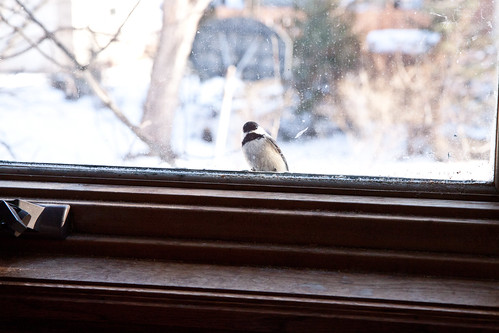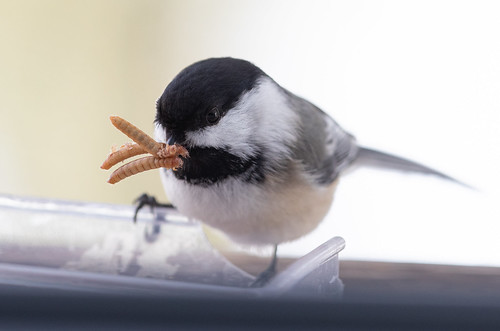Of all the food items I give my backyard birds, mealworms are the one so attractive to birds that they make it relatively easy to entice chickadees and even a few Red-breasted and White-breasted Nuthatches to alight on my hand to take them.
Mealworms are beetles belonging to the species Tenebrio molitor—a member of the “darkling beetle” family, Tenebrionidae. They are probably native to the Mediterranean—the oldest archaeological records of them can be traced to Bronze Age Turkey, but they’re absent from archaeological finds of ancient Egypt. They’ve colonized much of the world thanks to human trade, almost certainly originally as freeloaders in grain, pretty much like Norway rats and house mice. They aren’t pests here in America except where grain is stored.
Like most insects, mealworms have four life stages, starting as virtually microscopic eggs which hatch into larvae—the part of the life cycle we call mealworms. Hatchlings are too tiny to see, but over the coming weeks they molt 9 to 20 times, each time bursting out of their sturdy, golden skin as a whitish, soft-skinned, slightly larger grub whose skin quickly hardens and turns soft golden brown.
When they’re as big as they get, they’ll molt one final time a pupa, shorter and much more flattened than the larva, looking like a tiny curled-up dragon, whitish at first but turning soft brown.
 |
| Photo from Wikipedia user Dominik Hoffmann |
Like butterflies in a chrysalis or moths in a cocoon, pupae do not eat anything at all. Three days to a month after pupating, the adult beetle emerges, quite pale at first but quickly becoming black. In my experience, mealworm beetles never open their wing covers to fly at all, so are easily contained in the same bucket as the larvae. The adults eat pretty much the same food as the larvae, as far as I can tell, and mate, females producing as many as 500 eggs before dying.
| Photo from Wikipedia user Sanja565658 |
In deserts and forests, this ground-dwelling species feeds on plant tissue and dead insects, becoming a pest if it finds its way into stored grain, but as with Norway rats and house mice, people have found a lot of important uses for mealworms. In 1968, they were among the first terrestrial organisms to travel to and circle the moon aboard Zond 5 on a Soviet space mission. In 2015, studies showed that mealworms can degrade polystyrene into usable organic matter, though so far this hasn’t been commercialized.
Over the world, they’re commonly used as fish bait and pet food for reptiles, fish, and birds, and in many places are also raised for human consumption. In May 2017, mealworms were approved as food in Switzerland, and in 2021, dried mealworms were authorized as novel food in the European Union after the European Food Safety Authority assessed the larvae as safe for human consumption.
Mealworms are very nutritious. Every 100 grams of raw mealworm larvae provide 206 calories and 14 to 25 grams of protein, along with potassium, copper, sodium, selenium, iron and zinc, essential linoleic acids, and a greater vitamin content by weight than beef.
I first learned about mealworms as a bird rehabber in the 1980s. They were especially important for feeding baby birds and nighthawks of all stages, and my educational Blue Jay Sneakers loved them, so I used to buy them in batches of about 20,000 at a time. I kept them in ice cream buckets with a couple of inches of oatmeal, adding slices and peelings from apple, carrot, or potato to give the mealworms all the moisture they needed. To make the mealworms even more nutritious for baby birds, I added a quarter cup or so of a commercial mix for hand-feeding baby birds.
The mealworms were shipped in burlap bags filled with wadded-up newspaper. When a shipment arrived, I quickly transferred them to my buckets to minimize the amount of newsprint they consumed, which I figured could not be good for the mealworms or the birds that ate them. In nice weather, I did this on my picnic table. Little by little, neighborhood chickadees and jays figured out what I was doing and would come right down to watch and grab some for themselves.
In the 1990s, mealworms became increasingly popular among people with nesting bluebirds—they worked out ways of making bluebird feeders and boasted about how many mealworms a single bluebird could carry away to feed its young. Unfortunately, as nutritious as mealworms are, birds need more variety than any single species can provide—now sensible bluebird lovers limit the number of mealworms they provide each day. I’ve never lived in bluebird habitat, so never tested out any bluebird feeders. I kept offering live mealworms when a pair of chickadees were raising young in my yard last summer, but despite my monitoring, only a couple of times did I see them taking a mealworm to the nest. The parents used the mealworms as quick pick-me-ups between searching out more varied and nutritious caterpillars for the chicks.
Mealworms are expensive in small quantities, and a lot of birds eat them, so it would be prohibitively expensive and complicated for me to feed huge amounts to wild birds. I put them in small window feeders where I can enjoy watching the variety of birds coming to them. If they discover them, robins take a lot, and small woodpeckers, including Red-bellieds, also love them. In spring when I noticed robins grabbing 10 or 15 at a time to feed their nestlings, I knew it was time to cut back for the season. Robins never noticed them last year when I kept offering them throughout my chickadees’ nesting cycle—they didn’t spend much time in that part of my yard.
Like people, most birds associate bird feeders with seeds and suet, and when you first offer mealworms, it can take time for birds to notice. The ones that spend time near your feeder notice and figure them out most readily when the mealworms are wriggling. When the temperature is below 10º F or so, the mealworms stop moving within a second or two of being put outside, and don’t move very long even when the temperature is in the 30s or 40s. But once birds figure them out, they check the feeder and are perfectly happy with frozen mealworms.
Now a lot of stores sell dried mealworms, which is simpler and more economical while ostensibly providing the same nutrition. I scatter a handful of dried mealworms on my window feeder every morning on top of the main food, Fiery Feast, and a bit of millet and Nyjer seed. My chickadees and nuthatches clearly prefer fresh mealworms, still wiggling or frozen solid, taking them over anything else I offer. Then they take the peanuts and other nuts from the Fiery Feast. I’m not sure if the loss in weight in the drying process makes dried mealworms feel flimsy compared to live and frozen ones and to larger seeds, if they are less palatable, or if they lose food value compared to lives ones, but my chickadees and nuthatches do take them before eating the other seeds in my feeder.
Many people prefer offering dried mealworms to live ones for good reasons. They’re more economical, don’t require any maintenance, and aren’t wriggly. I’m not squeamish about hardly anything—my worst problem with live mealworms is when I start paying attention to them as helpless little individuals, feeling sad and guilty about their fate. The one time I do feel a bit squeamish is when a chickadee breaks protocol and instead of grabbing one to eat on a tree branch, it hunkers down and eats it right in my hand. Chickadees don’t swallow mealworms whole but rather peck at them, frequently wiping their goopy bills on the nearest branch or finger. There is just one word for that. Yuck.








